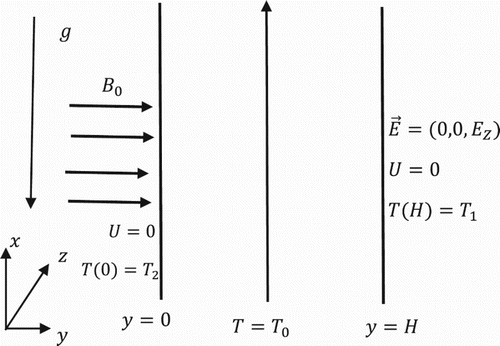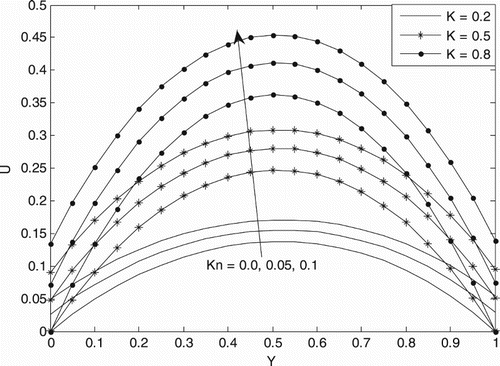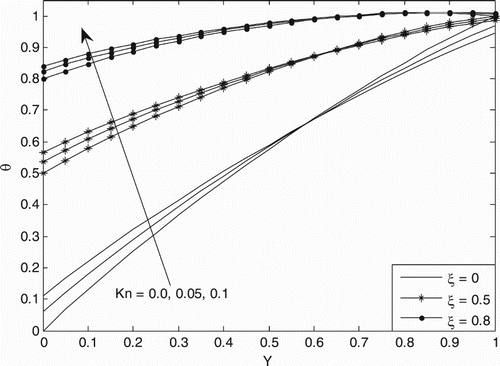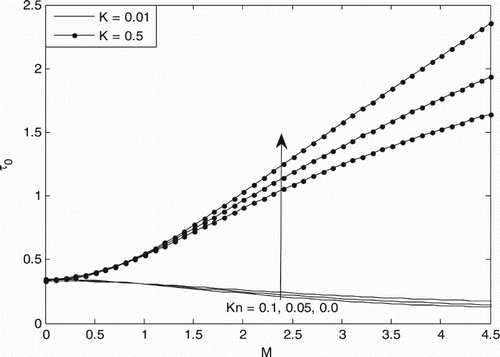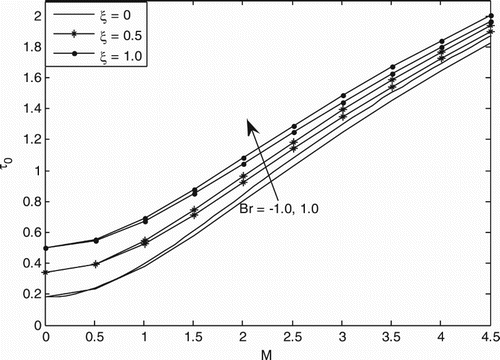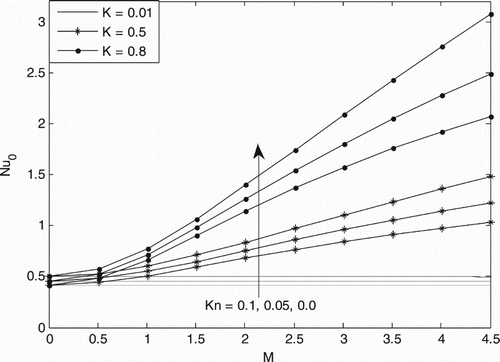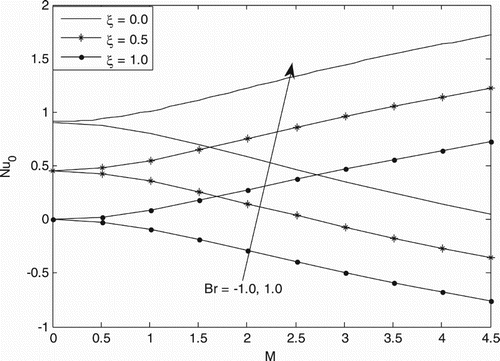 ?Mathematical formulae have been encoded as MathML and are displayed in this HTML version using MathJax in order to improve their display. Uncheck the box to turn MathJax off. This feature requires Javascript. Click on a formula to zoom.
?Mathematical formulae have been encoded as MathML and are displayed in this HTML version using MathJax in order to improve their display. Uncheck the box to turn MathJax off. This feature requires Javascript. Click on a formula to zoom.ABSTRACT
This article explores the combined role of Joule heating and transversely applied magnetic field on natural convection flow in a vertical microchannel with asymmetric wall heating. The governing momentum and energy equations are obtained and transformed to their corresponding dimensionless form using suitable dimensionless parameters. Exact solutions are obtained for the coupled momentum and energy equations and presented graphical to understand the role of governing dimensionless parameters. During the course of numerical and graphical simulations, the results indicate that the presence of Joule heating and electromagnetic field lead to enhancement of fluid velocity, temperature, skin-friction and Nusselt number in the microchannel. In addition, the heat transfer can be improved when heat is been transported from the walls of the microchannel to the fluid and for purely asymmetric wall heating compared to the case when heat is transfer from the fluid to the wall.
Nomenclature
| = | magnetic field strength | |
| = | Brinkman number | |
| = | specific heats at constant pressure and constant volume, respectively | |
| = | electric field | |
| = | acceleration due to gravity | |
| = | width of the channel | |
| = | magnetic field induction vector | |
| = | dimensionless Joule heating parameter | |
| = | Knudsen number | |
| = | Hartmann number | |
| = | Nusselt number | |
| = | dimensionless volume flow rate | |
| = | dimensional temperature | |
| = | reference temperature | |
| = | dimensional axial velocity | |
| = | dimensionless axial velocity | |
| = | mean velocity | |
| = | axial and transverse coordinate respectively | |
| = | dimensionless axial coordinate | |
| = | dimensionless transverse coordinate | |
| = | thermal expansion coefficient | |
| = | dimensionless variables | |
| = | wall-ambient temperature difference ratio | |
| = | thermal and tangential momentum accommodation coefficients, respectively | |
| = | ratio of specific heats ( | |
| = | fluid–wall interaction parameter, | |
| = | dynamic viscosity | |
| = | kinematic viscosity | |
| = | density | |
| = | dimensionless temperature | |
| = | mean free path | |
| = | electric conductivity | |
| = | skin-friction |
Subscripts
| = | value at | |
| = | value at | |
| = | mean |
1. Introduction
With continuous increase in customers’ demand for micro-electro-mechanical system (MEMS) and nano-electro-mechanical systems due to their applications in cooling or heating in micro-reactor devices, many studies have been devoted to satisfy their demands. Recent applications of such devices include microchannel heat sink, microjet impingement cooling and microheat pipe. Therefore, a thorough understanding of flow behaviours in microchannel is becoming increasingly important for accurate prediction of performance during the design process. Although there are a remarkably growing number of realized scientific and engineering applications found for MEMS devices, understanding the fluid dynamics and heat transfer processes in such MEMS devices is still far from being thorough. On the other hand, the performance of MEMS often defies predictions made using scaling laws developed for large systems. So, heat can be easily built up in a densely packed MEMS protective housing, which may cause undesirable or even destructive deformation. Therefore, there is a pressing need of reliable computational capabilities for accurate predictions of these devices.
The Knudsen number is the major parameter that decides the division of rarefied gas flow and is defined as the ratio of the molecular mean free path to characteristic length scale. For a given fluid flow problem, when
, the flow domain can be treated as a continuum, in which the Navier–-Stokes equation in conjunction with the no-slip wall boundary conditions becomes applicable. For
, the flow becomes free molecular in nature, because of negligible molecular collisions. For
, the slip flow regime is considered and the no-slip boundary condition becomes invalid, though continuum conservation equations are used to characterize the bulk flow. For
, the transition flow regime occurs and the continuum hypothesis progressively ceases to work totally [Citation1,Citation2]. In this study, the slip flow regime
is considered in order to study the hydrodynamic and thermal behaviour of fully developed electromagnetohydrodynamics natural convection flow in a vertical channel. A lot of articles have been devoted to solve flow formation problems in microchannel. Chen and Weng [Citation3] studied analytically the fully developed natural convection in an open-ended vertical parallel plate microchannel with asymmetric wall temperature. They concluded that the effects of rarefaction and fluid wall interaction enhanced the volume flow and reduced the heat transfer rate. This result was further extended by taking into account suction/injection on the microchannel walls by Jha et al. [Citation4]. They resolved that skin-friction as well as rate of the heat transfer strongly depends on the suction/injection parameter. Other related work on flow formation in microchannel can be found in [Citation5–8].
Joule heating effect on flow of electrically conducting fluid in the presence of transversely applied magnetic field on the other hand has yielded a promising result in the area of power generation, nuclear energy production, electric oven, transformers, soldering iron, electric hotplate, electric radioactive space heater, incandescent bulbs, electronic cigarettes and magnetohydrodynamics (MHD) pump. Some of these notable achievements can be found in the work of Cramer and Pai [Citation9], Chawla [Citation10] and Soundalgekar and Takhar [Citation11]. Recently, Jha et al. [Citation12] investigated the MHD natural convection flow in a vertical parallel plate microchannel and found that the magnitude of skin-friction is higher in the case of symmetric heating in comparison with asymmetric wall heating of microchannel plates. The study of the effect of electrically conducting walls with MHD is significant in the design of MHD micropumps [Citation13]. Soundalgekar [Citation14,Citation15] investigated the role of electrically conducting walls on MHD channel flow of an incompressible, viscous rarefied gas as affected by wall conductance. It was concluded that velocity is a decreasing function of magnetic field. Later, Soundalgekar [Citation16] derived an expression for the Nusselt number by incorporating slip/jump boundary conditions at the walls for parallel plate microchannel of an electrically conducting fluid. In the other related article, Shojaeian and Shojaeian [Citation17] presented an analytical solution of mixed electromagnetic/pressure-driven gaseous flows in microchannels. They examined the Nusselt number and Poiseuille number and concluded that the role of electromagnetic field is to increase the Nusselt number and Poiseuille number in regions with less rarefaction. Other researchers who have contributed to the study of electromagnetic field effect on flow formation are the authors of [Citation18–25].
Despite all these contributions, to the best of authors’ findings, no analytical work has been carried out to investigate the electromagnetic flow in a vertical microchannel when the flow is driven by buoyancy (natural convection).
In view of this, the aim of this article is to examine the role of Joule heating and electromagnetic field on natural convection flow formation and heat transfer in a microchannel. Exact solutions are obtained for fluid velocity, temperature, skin-friction and Nusselt number. The role of governing parameters is graphical represented, discussed and significant conclusions are drawn. The novelty of this current article is to present an exact solution for combined magnetic field and Joule heating of natural convection flow in a vertical microchannel.
1.1. Problem description
Consider a fully developed natural convection flow of electrically conducting fluid in a vertical microchannel with a width in the presence of electromagnetic field, buoyancy and Joule heating. The x-axis is parallel to the gravitational acceleration
but in the opposite direction, while the y-axis is orthogonal to the vertical parallel plates. A magnetic field of uniform strength
is assumed to be applied in the direction perpendicular to the direction of flow. It is assumed that the magnetic Reynolds number is very small, which corresponds to negligibly induced magnetic field compared to the externally applied one. The plates are heated asymmetrically with one plate
maintained at a temperature
greater than the fluid temperature
while the other plate
at a temperature
where
. Due to this temperature difference at the channel walls which would result to density difference, hence natural convection flow is set up in the microchannel. The geometry of the system under consideration in this present study is shown in . The flow is assumed to be steady and incompressible with constant properties. Also, the viscous dissipation term in the energy equation is neglected and the external electric field exists in the z-direction only such that
. Following Cai and Liu [Citation26] and Shojaeian and Shojaee [Citation27], the electrical field can be combined with the magnetic field with
, where
.
1.2. Mathematical formulation
Considering all the above assumptions, the mathematical models representing the electromagnetohydrodynamics flows are obtained by incorporating the Lorentz force and Joule heating term in the momentum and energy equations respectively are as follows:
(1)
(1)
(2)
(2)
where
is the Joule heating term and
.
Considering a steady, incompressible, electrically conducting, fully developed flow in the absence of pressure gradient, the governing equations respectively reduce to
(3)
(3)
(4)
(4)
Using the following dimensionless parameters, Equations (3)–(4) become [Citation12,Citation27]
(5)
(5)
(6)
(6)
(7)
(7)
The boundary conditions governing the problem in a vertical microchannel in dimensionless form are represented as follows:
(8)
(8)
1.2.1. Analysis
Differentiating Equation (6) twice and substituting Equation (7), the coupled equations can be decoupled as follows:
(9)
(9)
The exact solution of Equation (9) with boundary conditions (8) for the momentum and energy equations can be obtained respectively as follows:
(10)
(10)
(11)
(11)
where
are constant defined as follows:
(12)
(12)
where
are constants defined in the Appendix.
The drag effect at the surfaces of the microchannel is given by
(13)
(13)
(14)
(14)
Another important quantity of interest is the volume flow rate which is defined in the dimensionless form as follows:
(15)
(15)
Also, the rate of heat transfer represented by the Nusselt number
in the dimensionless form for fully developed laminar flow in a microchannel is given as follows:
(16)
(16)
where
is the bulk temperature defined as follows:
(17)
(17)
where
are constants defined in the Appendix.
(18)
(18)
(19)
(19)
2. Results and discussion
The coupled momentum and energy equations are solved exactly and the solutions obtained are used to obtain the expressions of interest, such as bulk temperature, skin-friction and Nusselt number. The graphs are depicted to reveal the role of pertinent parameters such as Hartmann number, Brinkman number, Knudsen number and the electric field strength. Throughout this article, the Hartmann number has been selected over the range of in order to avoid induced magnetic field,
,
to capture both the continuum regime and slip regime,
to capture the cases of purely asymmetric and symmetric wall heating,
to illustrate the cases when heat is supplied to the fluid from the walls and vice versa.
2.1. Velocity field
The exact solution obtained for the velocity profile in Equation (10) is graphical represented to show the effect of various governing parameters. shows the velocity profile for different flow regimes and electric field strength at a fixed value of Hartmann number
,
and
. It is found from this figure that the velocity as well as the velocity slip increases with increase in
and
. Also, the maximum velocity is obtained for the slip regime. This is due to the fact that for slip regime, the ratio of molecular mean free path to the channel width is higher and thereby breaking the continuum assumption, hence giving the fluid free movement, thereby enhancing fluid motion in the vertical microchannel.
On the other hand, illustrates the combined role of Hartmann number and Joule heating parameter for the fixed value of and
. It is evident from this graph that the role of magnetic field is to increase the fluid velocity in the presence of Joule heating. This trend could be attributed to the presence of Joule heating which is converse to the well-known result that “Hartmann number reduces fluid velocity due to the presence of Lorentz force which opposes fluid velocity”. As an accuracy check, it is observed that for small value of
(in the absence of Joule heating), velocity profile decreases with increase in Hartmann number
. This accuracy check corresponds to the results of Jha et al. [Citation12] ().
Table 1. Numerical comparison of the present dimensionless velocity for different flow regimes with those of Jha et al. [Citation12] at M=0.
2.2. Temperature distribution
This section is concerned with the discussion of role of transversely applied magnetic field and Joule heating on the temperature distribution in the microchannel for different values of governing parameters. It is good to state that for small value of Joule heating parameter, the temperature distribution corresponds exactly with that of Jha et al. [Citation12]. presents the combined role of Knudsen number and wall-ambient temperature ratio
on the temperature distribution in the microchannel for the fixed value of Joule heating parameter
and Hartmann number
for the case when heat is supplied from the wall to the fluid
. It is found that temperature jump increases with increase in
and
at the wall with ambient temperature ratio, while the reverse result is noticed at the wall with symmetric heating. This can be attributed to the fact that as
, the temperature also increases gradually until symmetric wall heating is achieved and thereby enhancing the temperature distribution in the microchannel. On the other hand, temperature distribution is lower for the slip flow regime
at the wall with symmetric heating. This accounts to the fact that for the slip regime, the continuum assumption is no more valid and hence the mean molecular free path is higher, therefore leading to drop in the temperature distribution in the microchannel.
For variation of temperature distribution for different values of Joule heating parameter and Hartmann number
. depicts the role of these parameters on the dimensionless fluid temperature near the region close to the slip regime
. It is established that the combined role of Joule heating and magnetic field (electromagnetic) is to increase the fluid temperature. As expected, in the absence of Joule heating
, the temperature distribution is independent of the electromagnetic field. This corresponds to the findings of Jha et al. [Citation12], where their energy equation is independent of the electromagnetic field. This finding can help enhancement of heat transfer appliances, such as heaters, soldering iron, pressing iron and other electrical appliances.
2.3. Skin-friction
The solution to the momentum equation obtained is utilized to compute the drag force (skin-friction) between the fluid and the surfaces of the vertical microchannel. This parameter is of great interest in determining and understanding the capacity of dam and hydropower generation. exhibits the role of Joule heating and transversely applied magnetic field on skin-friction at the wall with ambient temperature ratio at different flow regimes for the fixed value . It is obvious from this figure that in the absence of magnetic field, skin-friction is independent of
or
. On the other hand, the role of
is to increase the skin-friction at this surface as Joule heating parameter
increases, while the reverse is the result in the absence of Joule heating parameter
. In order to get further understanding on the present research skin-friction, gives the combined role of Brinkman number
and wall-ambient temperature ratio
on drag effect at the microchannel wall for the fixed value of
and
. It is obvious that skin-friction is higher when heat is supply from the wall to the fluid
than for the case when heat is supplied from the fluid to the wall
. In addition, as the wall-ambient temperature ratio approaches symmetric heating
, the maximum skin-friction is achieved regardless of the source of heating. In general, the reverse results are found for skin-friction at the wall with symmetric wall heating and for brevity, it has not been reported in this article.
2.4. Heat transfer
One of the most important analyses in fluid mechanics is the heat transfer. This is due to the need to satisfy customers’ demands and make life easier both in living apartment and industrial applications which include thermostat mechanism, drying machines, air conditioners and ovens. This section is concerned with the role of governing parameter on the overall heat transfer (represented by the Nusselt number) between the microchannel walls and the fluid. displays the role of Joule heating parameter and Hartmann
on the heat transfer at the wall with ambient wall temperature ratio for the fixed value of
and
. It is interesting to find that the Nusselt number is enhanced by increase in
and
regardless of its flow regime. Also, as expected, the heat transfer is higher for continuum regime
than in slip flow regime
. On the other hand, in the absence of Joule heating, the heat transfer is independent of
and it assumes the value of the wall-ambient temperature ratio
.
illustrates the Nusselt number as a function of
and
for the fixed value of
at slip flow regime. One can infer that the heat transfer increases with
when heat is supplied to the fluid from the heated wall and decreases otherwise. Obviously, for purely asymmetric heating
, more heat is transferred from the heated wall to the fluid, while the lowest heat is transferred as
. This is because for symmetric heating, the temperature change between the fluid and the heated wall is very infinitesimal, hence low heat is transferred as it almost attains saturation state. It is good to note that in the absence of magnetic field
, the heat transfer in the microchannel is independent of
.
3. Conclusion
This article is devoted to investigate the combined role of Joule heating and transversely applied magnetic field on buoyancy-driven flow of an electrically conducting fluid in a vertical microchannel with asymmetric wall heating. An exact solution is obtained for the momentum and energy equations and depicted graphically to see the role of governing parameters. Based on the solutions and graphical representations obtained, the following conclusions can be drawn:
Velocity, temperature, skin-friction and Nusselt number increase with Hartmann number in the presence of Joule heating.
Skin-friction and Nusselt number are higher in the continuum regime than the slip regime.
The maximum heat transfer is achieved when heat is been transferred from the walls to the fluid and for purely asymmetric wall heating.
Disclosure statement
No potential conflict of interest was reported by the authors.
References
- Schaaf SA, Chambre PL. Flow of rarefied gases. Princeton, NJ: Princeton University Press; 1961.
- Jha BK, Oni MO, Aina B. Steady fully developed mixed convection flow in a vertical micro-concentric-annulus with heat generating/absorbing fluid: an exact solution. Ain Shams Eng J. 2016. doi: 10.1016/j.asej.2016.08.005
- Chen CK, Weng HC. Natural convection flow in a vertical microchannel. J Heat Transf. 2005;127:1053–1059. doi: 10.1115/1.1999651
- Jha BK, Aina B, Joseph SB. Natural convection flow in a vertical micro-channel with suction/injection. J Process Mech Eng. 2014;228(3):171–180. doi: 10.1177/0954408913492719
- Devi SP, Suriyakumar B. Effect of magnetic field on blasius and sakiadis flow of nanofluids past an inclined plate. J Taibah Univ Sci. 2017;11(6):1275–1288. doi: 10.1016/j.jtusci.2017.03.004
- Yu S, Ameel TA. Slip-flow heat transfer in rectangular microchannels. Int J Heat Mass Transfer. 2001;44:4225–4234. doi: 10.1016/S0017-9310(01)00075-8
- Jha BK, Oni MO. Impact of mode of application of magnetic field on rate of heat transfer of rarefied gas flow in a microtube. Alexandria Engr J. 2017. doi: 10.1016/j.aej.2017.03.029
- Biswal L, Som SK, Chakraborty S. Effects of entrance region transport processes on free convection slip flow in vertical microchannels with isothermally heated walls. Int J Heat Mass Transfer. 2007;50:1248–1254. doi: 10.1016/j.ijheatmasstransfer.2006.09.025
- Cramer KR, Pai S. Magneto fluid dynamics for engineers and applied physicists. New York (NY): McGraw-Hill; 1973.
- Chawla SS. Magnetohydrodynamics unsteady free convection. ZAMM. 1967;47:499–508. doi: 10.1002/zamm.19670470803
- Soundalgekar VM, Takhar HS. On MHD flow and heat transfer over a semi-infinite plate under transverse magnetic field. Nucl Eng Des. 1977;42:233–236. doi: 10.1016/0029-5493(77)90184-4
- Jha BK, Aina B, Ajiya AT. MHD natural convection flow in a vertical parallel plate microchannel. Ain Shams Eng J. 2014. https://doi.org/10.1016/j.asej.2014.09.012.
- Lemoff AV, Lee AP. An AC electrohydrodynmmaics micropump. Sensor Actuat B. 2000;63:178–185. doi: 10.1016/S0925-4005(00)00355-5
- Soundalgekar VM. MHD channel flow of an electrically conducting, incompressible, viscous, rarefied gas as affected by wall electrical conductances. Proc Natl Inst Sci India Part A. 1967;33:276–280.
- Soundalgekar VM. Steady MHD couette flow between two conducting walls of an electrically conducting, viscous, incompressible, rarefied gas. Proc Natl Inst Sci India Part A. 1968;35:251–261.
- Soundalgekar VM. On heat transfer in MHD channel flow in slip-flow regime. Proc Natl Inst Sci India Part A. 1969;35:439–445.
- Shojaeian M, Shojaeian M. Analytical solution of mixed electromagnetic/pressure driven gaseous flows in microchannels. Microfluid Nanofluid. 2012;12:533–564. doi: 10.1007/s10404-011-0897-z
- Bhatti MM, Zeeshan A, Ellahi R. Electromagnetohydrodynamic (EMHD) peristaltic flow of solid particles in a third-grade fluid with heat transfer. Mech Ind. 2017;18(3):314. doi: 10.1051/meca/2016061
- Bhatti MM, Abbas MA, Rashidi MM. A robust numerical method for solving stagnation point flow over a permeable shrinking sheet under the influence of MHD. Appl Math Comput. 2018;316:381–389.
- Ellahi R, Bhatti MM, Vafai K. Effects of heat and mass transfer on peristaltic flow in a non-uniform rectangular duct. Int J Heat Mass Transf. 2014;71:706–719. doi: 10.1016/j.ijheatmasstransfer.2013.12.038
- Ellahi R, Bhatti MM, Pop I. Effects of hall and ion slip on MHD peristaltic flow of jeffrey fluid in a non-uniform rectangular duct. Int J Numer Methods Heat Fluid Flow. 2016;26(6):1802–1820. doi: 10.1108/HFF-02-2015-0045
- Ellahi R, Bhatti MM, Fetecau C, et al. Peristaltic flow of couple stress fluid in a non-uniform rectangular duct having compliant walls. Commun Theor Phys. 2016;65(1):66–72. doi: 10.1088/0253-6102/65/1/66
- Bhatti MM, Sheikholeslami M, Zeeshan A. Entropy analysis on electro-kinetically modulated peristaltic propulsion of magnetized nanofluid flow through a microchannel. Entropy . 2017;19(9):481. doi: 10.3390/e19090481
- Bhatti MM, Ellahi R, Zeeshan A. Heat transfer with thermal radiation on MHD particle-fluid suspension induced by metachronal wave. Pramana. 2017;89(3)48. doi: 10.1007/s12043-017-1444-6
- Jha BK, Oni MO. Fully developed mixed convection flow in a vertical channel with electrokinetic effects: exact solution. Multidiscipline Modelling in Materials and Structures. DOI:10.1007/s12043-017-1444-6.
- Cai C, Liu D. Asymptotic solutions for low-magnetic-Reynolds-number gas flows inside a two-dimensional channel. AIAA J. 2009;47:542–551. doi: 10.2514/1.37060
- Shojaeian S, Shojaeee SMN. Viscous dissipation effect on heat transfer characteristics of mixed electromagnetic/pressure drivenliquid flows inside micropumps. Korean J. Chem. Eng. 2013;30(4):823–830. doi: 10.1007/s11814-012-0233-9
Appendix

